The ASUS ZenFone 2 Review
by Brandon Chester on May 26, 2015 8:00 AM ESTDisplay
In recent times we've seen a tremendous improvement in smartphone and tablet display quality. It began with high end flagship phones, and eventually trickled down to more budget oriented smartphones. Even a $130 smartphone like the 2015 Moto E can have a decent IPS display. However, I'm hesitant to describe the Zenfone 2 as a "budget" smartphone. While I don't mean for the word to have negative implications, it's often interpreted as meaning low quality or cheap. The Zenfone 2 is better described as an inexpensive smartphone. Much like the OnePlus One did when it was released, the Zenfone 2 offers some very serious hardware at a price much lower than what has become the going rate for flagship smartphones.
The display in the Zenfone 2 is a 5.5" 1920x1080 IPS LCD panel. This is another specification that you would expect to see in a $650 flagship device that is instead inside one that starts at $199. While phones are now moving to 2560x1440, on RGB stripe panels I don't feel that there are significant benefits to moving past 1080p even on 5.5" displays. On top of that, a display's resolution is just one of many attributes that contributes to its quality. Color accuracy, brightness, and contrast are all important aspects of a display. To accurately characterize these areas of display performance, we use SpectraCal's CalMAN 5 software and X-Rite's i1Pro 2 spectrophotometer.
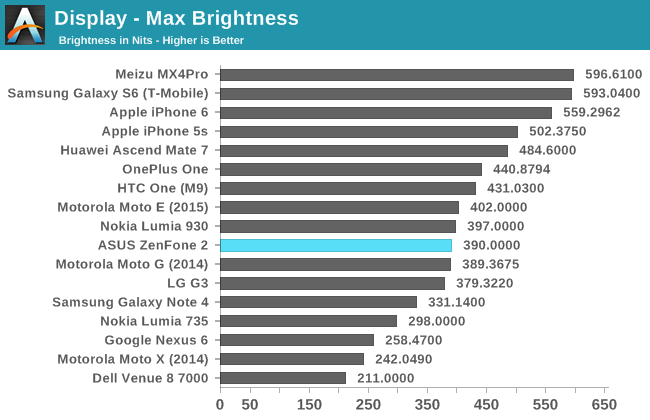
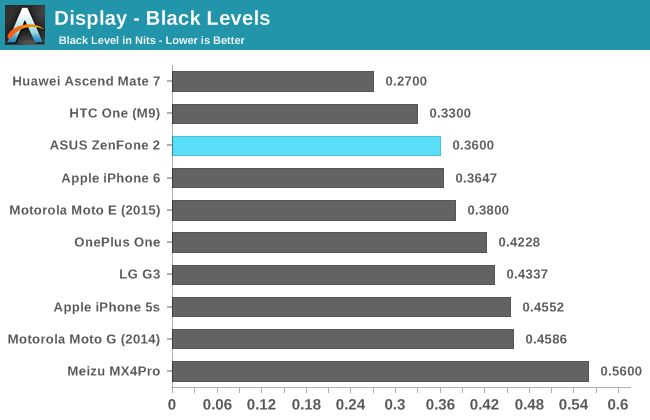
The Zenfone 2 appears to be off to a good start. Black levels are very low among our LCDs, and the max brightness is somewhat low but not terrible by any means. I never had any issues when using the Zenfone 2 outside, although it was definitely not as comfortable as the Galaxy S6.
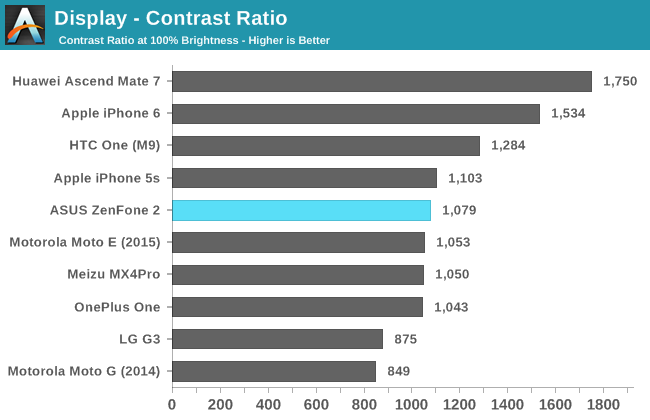
The slightly low max brightness and above average black level results put the Zenfone 2 right in the middle of our LCD devices when it comes to contrast ratio.
Unfortunately, these numbers are somewhat misleading. This is because the Zenfone 2 makes extremely heavy use of dynamic contrast and contect adaptive backlighting (CABC). I have never used another device with such dramatic shifts in backlight power. The best example I've found is when switching from an all black to all white screen at max brightness. While this is obviously an extreme case, it illustrates the behavior that is occuring very well. At the moment you switch to white, the brightness of the display is around 170 nits. Over the next few seconds, that brightness rapidly increases to the 390 nits you see in the results above. This is an enormous jump in brightness, and it's very easy to see with your own eyes.
One last thing I'd like to note about the brightness is that the 100% setting on the built in brightness slider is not actually the max brightness that the display is capable of. The max you can achieve using the slider in the Settings app is 319 nits, which is around 82% of the 390 nit result you can get using applications like Brightness Adjuster from Google Play.
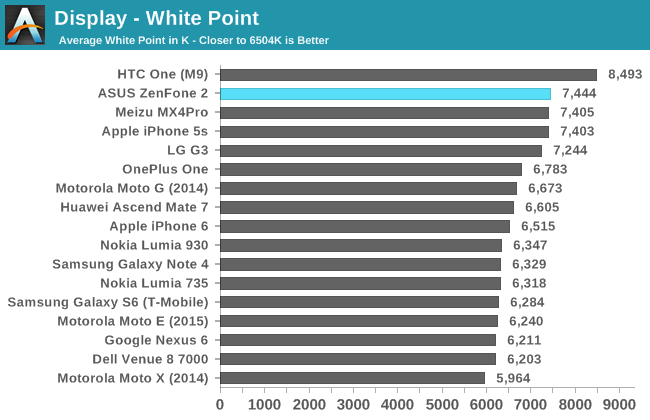
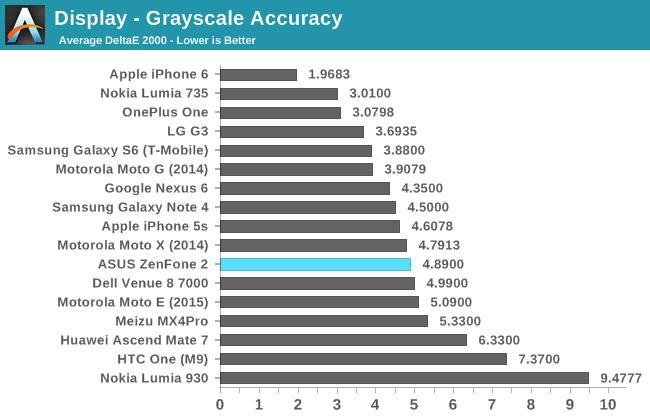
Greyscale accuracy on the Zenfone 2 is very average. The display is too blue, and this can be seen in the reproduction of shades of grey as their brightness goes beyond 15%. The gamma is also extremely irregular, and continually curves upward. This is the result of ASUS's heavy dynamic contrast and CABC. The brightness reductions with darker shades makes the display slower to move out of the shadows, which you can see in the color comparator chart above. Again I must reiterate that the color comparator is a relative color difference, as the bottom half which displays the "target" colors will be impacted by any inaccuracies in the display you use to view it.
Unfortunately, there's not much that can be done to improve greyscale accuracy when CABC is used heavily. Testing with constant APL patterns to try and avoid the brightness shifting did bring the gamma down to 2.4, but because the display still has a blue shift and the gamma is still too high, the average greyscale deltaE was around 4.5 which is still fairly high.
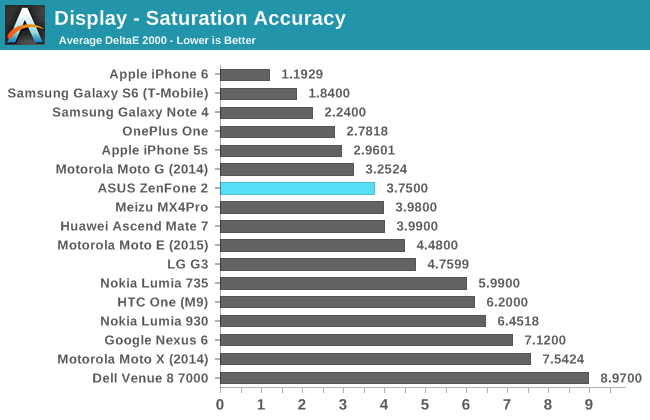
Saturation accuracy ends up being noticeably better than greyscale accuracy on the Zenfone 2. Blue and green manage to stay below the dE target of 3 for all saturation levels, while all the other colors hover somewhere between 4 and 6 on average. An average deltaE across all colors of 3.754 is not terrible by any means, and I don't think Zenfone 2 buyers will have any complaints about the accuracy of primary and secondary colors.
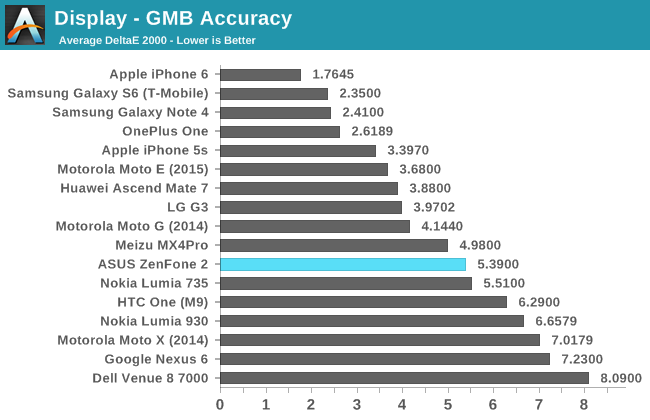
Unfortunately, the inaccurate greyscale and gamma of the Zenfone 2 comes back to haunt it in the Gretag MacBeth ColorChecker test. This test measures the accuracy of various color mixtures that are common in the real world, and the Zenfone 2 misses many of them by a significant degree. What's even more unfortunate is that the highest errors are in mixtures of yellow in red, with the largest error of all the colors tested being light skin tones. If there's one color I want a display to get right, it's skin tones.
The overall display performance of the ZenFone 2 is mixed at best. I'm glad it basically has the full sRGB gamut, and is fairly accurate with saturations of primary colors. However, it doesn't do very well when it comes to shades of grey, and it also has slightly lower accuracy with color mixtures than I had hoped. Devices like the 2015 Moto E show that it's possible to get close to that dE error target of 3 even on an inexpensive smartphone. I would still say that the ZenFone 2 has the best display at this price point purely on the merit of its pixel density, but I really wish that the calibration was better than it is.


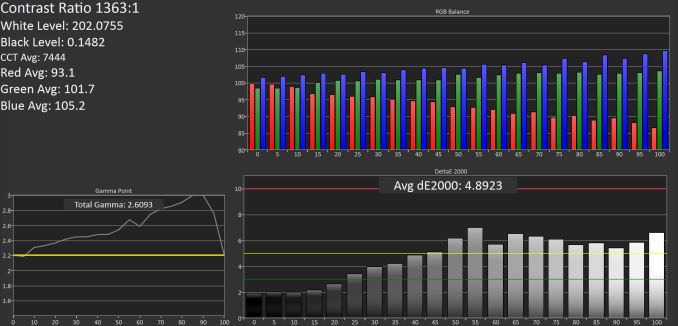

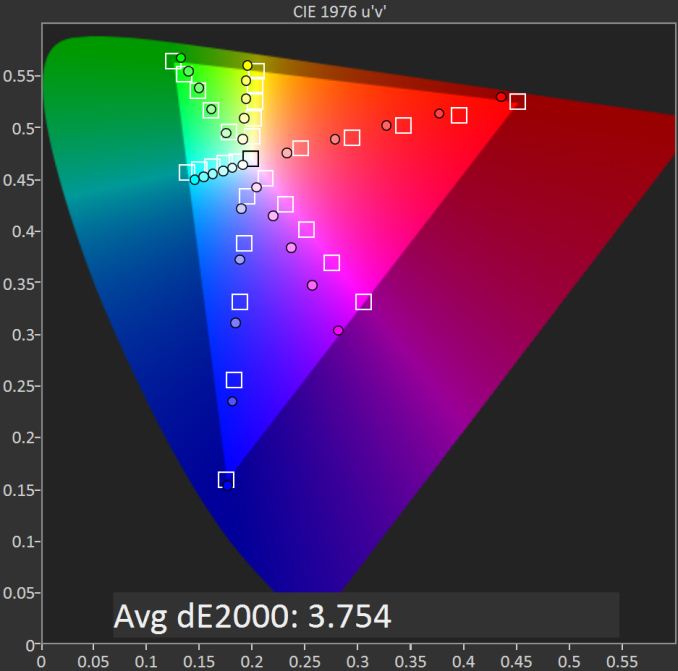









147 Comments
View All Comments
aungmyokhing - Friday, September 4, 2015 - link
Zenfone2 have Touch Screen Error. I bought last 3 months. Now appear that Error. Now I can't use my phone. Very stupid condition!aungmyokhing - Friday, September 4, 2015 - link
My phone have no damage. No cracked. That error was appear automatically.aungmyokhing - Friday, September 4, 2015 - link
I used Zenfone 2 ZE551ML. My phone serial number is F4AZFG02X506.aungmyokhing - Friday, September 4, 2015 - link
Zenfone 2 have the so many errors. That shouldn't for use.Lyte - Saturday, April 9, 2016 - link
I recently bought the Zenfone 2 4GB RAM 64 GB model, and I could say the battery life sucks. One time it lasted for only about 4 hours on minimal use, and Ive already uninstalled and/or disabled the apps which aren't very useful and are just battery drainers. Any suggestions on how I can improve it's batterly life? Also I came from a Galaxy J7, and I could say the display is subpar to that of the super AMOLED 1280x720 display of the J7.Mike0902 - Wednesday, June 8, 2016 - link
I bought the same model as you and have to agree that the battery life is a known problem with this phone. I could probably make it through the day just so long as I don't play power hungry games at anytime. When I bought this phone it seems people were blaming the OS saying it was a known problem with Android 5 and there would be an update to 5.1 which should improve the battery life. As yet after 8 long months no update has been received even though Asus have sent out other updates during that time. From what I can gather now is that Asus are planning to skip 5.1 and go straight to Android 6.0. I shall only believe it when I see it especially with the broken promises of 5.1. I did a test to see exactly what was eating the battery and first off did a test by turning everything off using 'flight mode', increasing the brightness to maximum and keeping the screen on continuously to see how long it lasted before the battery gave out. It stayed on for an incredible 8 hours before the battery cried enough. It clearly isn't the screen that is responsible and I now run my phone on 75% brightness whereas before I was dimming it in the belief if would make the battery last longer. I have Sonic Dash installed on my phone which is a known power hungry game but I can play that for as long as my Nokia 1520 which is surprising as I was expecting the battery to plummet as soon as I started playing. Even saved videos play at full brightness without a massive battery drain so just what is causing the battery life to be so crap when in normal use? I have 2 SIM cards installed with SIM 1 using 4G and that is known to be power hungry but the biggest fall of all is when you start to use the internet through Google Chrome. The battery literally goes into freefall and will drop at a rate of approximately 1% every minute so a full charge would give you less than 2 hours of web surfing which is abysmal compared with other phones, therefore it seems the biggest eater of power is that Intel 2.3GHz processor. I can have an hours calling time using 4G and only use 10% of the battery but anything that uses the internet, which is just about every app installed, has to be refused permission to auto start and run in the background eating up the power. You can deny virtually all the apps from starting using the Auto Start Manager and I have also found it helps to run Clean Master at regular intervals to close down apps that have been used and get rid of junk files that build up. It's not strictly the answer but it does help and it does make the battery last longer and just about sees me through a day. With regard to the promised upgrade to Android 6.0, I wouldn't hold your breath on that one, I shall only believe it when I see it.Mike0902 - Wednesday, June 8, 2016 - link
Just as an after thought, if you only want to use your phone for calling and texting through the day go into the settings and turn off mobile data. No app can drain power then.